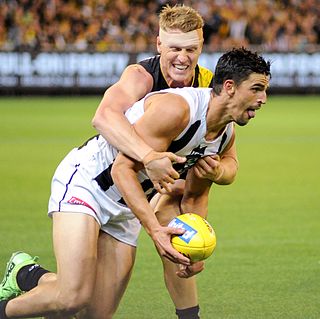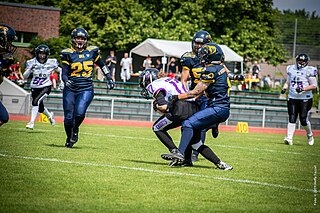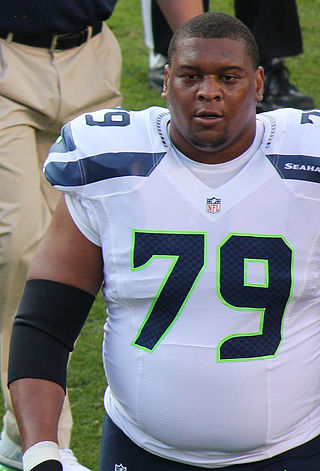Related Research Articles
In gridiron football, not all players on offense are entitled to receive a forward pass: only an eligible pass receiver may legally catch a forward pass, and only an eligible receiver may advance beyond the neutral zone if a forward pass crosses into the neutral zone. If the pass is received by a non-eligible receiver, it is "illegal touching". If an ineligible receiver is beyond the neutral zone when a forward pass crossing the neutral zone is thrown, a foul of "ineligible receiver downfield" is called. Each league has slightly different rules regarding who is considered an eligible receiver.

Most forms of football have a move known as a tackle. The primary purposes of tackling are to dispossess an opponent of the ball, to stop the player from gaining ground towards goal or to stop them from carrying out what they intend.

American and Canadian football are gridiron codes of football that are very similar; both have their origins partly in rugby football, but some key differences exist between the two codes.
In American and Canadian gridiron football, pass interference (PI) is a foul that occurs when a player interferes with an eligible receiver's ability to make a fair attempt to catch a forward pass. Pass interference may include tripping, pushing, pulling, or cutting in front of the receiver, covering the receiver's face, or pulling on the receiver's hands or arms. It does not include catching or batting the ball before it reaches the receiver. Once the ball touches any defensive player or eligible offensive receiver, the above rules no longer apply and the defender may tackle the receiver or attempt to prevent them from gaining control of the ball. Once a forward pass is in the air it is a loose ball and thus any eligible receiver – all defensive players are eligible receivers – may try to catch it. When a defensive player catches a forward pass it is an interception and their team gains possession of the ball. Some actions that are defined as pass interference may be overlooked if the defender is attempting to catch or bat the ball rather than focusing on the receiver.
Larry Christopher Allen Jr. is an American former professional football guard in the National Football League (NFL) for fourteen seasons, primarily with the Dallas Cowboys. He played college football at Sonoma State and was selected by the Cowboys in the second round of the 1994 NFL Draft. Allen is regarded as one of the NFL's physically strongest players ever, while also capable of using his speed against defenders.

Kimo K. von Oelhoffen is a former American football defensive tackle who played in the National Football League (NFL). He was selected by the Cincinnati Bengals in the sixth round of the 1994 NFL Draft. He played college football at Boise State.
A formation in American football refers to the position players line up in before the start of a down. There are both offensive and defensive formations and there are many formations in both categories. Sometimes, formations are referred to as packages.
Jerome McDougle is a former American football defensive end. He was drafted by the Philadelphia Eagles 15th overall in the 2003 NFL Draft. McDougle played college football at the University of Miami. He has also played for the New York Giants.

The horse-collar tackle is an American football maneuver in which a defender tackles another player by grabbing the back collar or the back-inside of an opponent's shoulder pads and pulling the ball carrier directly downward violently in order to pull his feet from underneath him. The technique is most closely associated with Pro Bowl safety Roy Williams.

In football, the tackle-eligible play is a forward-pass play in which coaches will attempt to create mismatches against a defense by inserting an offensive tackle, into an offensive formation as an eligible receiver, usually as a tight end or as a fullback. This is done by changing the formation of the offensive line, via positioning two linemen on one side of the center and three linemen on the other.

High school football is gridiron football played by high school teams in the United States and Canada. It ranks among the most popular interscholastic sports in both countries, but its popularity is declining, partly due to risk of injury, particularly concussions. According to The Washington Post, between 2009 and 2019, participation in high school football declined by 9.1%. It is the basic level or step of tackle football.

Joseph Anthony "Red" Bryant is a former American football defensive tackle. He played college football at Texas A&M, and was drafted by the Seattle Seahawks in the fourth round of the 2008 NFL Draft. Bryant also played for the Jacksonville Jaguars, Buffalo Bills and Arizona Cardinals.

In gridiron football, motion refers to the movement of an offensive player at the time of the snap.
The following terms are used in American football, both conventional and indoor. Some of these terms are also in use in Canadian football; for a list of terms unique to that code, see Glossary of Canadian football.

In gridiron football, a penalty is a sanction assessed against a team for a violation of the rules, called a foul. Officials initially signal penalties by tossing a bright yellow colored penalty flag onto the field toward or at the spot of a foul.
In gridiron football, blocking below the waist is an illegal block, from any direction, below the waist by any defensive player or by an offensive player under certain situations, by any player after change of possession, with certain exceptions. It is sometimes incorrectly referred to as a "chop block". Such blocks are banned due to the risk of injury, particularly those to the knee and ankle. The penalty for a block below the waist is 15 yards in the NFL, NCAA, and in high school. The block is illegal unless it is against the ball carrier.

Helmet-to-helmet collisions are occurrences in gridiron football when two players' football helmets make head-to-head contact with a high degree of force. Intentionally causing a helmet-to-helmet collision is a penalty in most football leagues, including many high school leagues.
In gridiron football, cut blocking is an offensive line technique that consists of an offensive player knocking a defensive player down by hitting his knees. The technique, which was initially instilled by Bobb McKittrick, the offensive line coach of the San Francisco 49ers from 1979 to 1999, is often criticized as being "dirty." Additionally, it is illegal for an offensive player to "cut" a defensive player already engaged with another offensive player. This is considered a "chop block", not a cut block. In the NCAA, cut blocking is allowed as long as the block is away from the original position of the ball. The Fall Experimental Football League and the NFL banned use of the chop block but the cut block remains a legal block in the NFL.

The run-pass option (RPO) is a type of designed option play in gridiron football in which the offensive team has the ability to either rush or pass the ball depending on the alignment and actions of defensive team. Like the standard read-option, the quarterback is responsible for viewing the actions of a particular defender and makes a decision to hand the ball off to their running back depending on how that defender chooses to act after the snap of the ball. However, unlike the read-option, the quarterback is responsible for making a decision regarding whether or not to throw a play-action pass to a receiver running a designed route, rather than simply the decision to keep the ball and run with it.
References
- ↑ Beacom, Michael (2010-08-03). The Complete Idiot's Guide to Understanding Football. ISBN 9781101458785.
- ↑ "NFL bans all chop blocks". ProFootballTalk. Retrieved 2023-04-14.
- ↑ NFL eliminates all 'chop' style blocks for 2016 season
- ↑ Drawn from Rule 12, Section 2, Article 3 Archived 2013-11-09 at the Wayback Machine
- ↑ Boyles, Bob; Guido, Paul (2007). 50 Years of College Football: A Modern History of America's Most Colorful Sport. p. 373. ISBN 9781602390904.
- ↑ Drawn from Rule 7, Section 2, Article 7 Archived 2012-05-11 at the Wayback Machine
- ↑ Baker, Hayden P.; Varelas, Antonios N.; Shi, Kevin; Terry, Michael A.; Tjong, Vehniah K. (April 23, 2018). "The NFL's Chop-Block Rule Change: Does It Prevent Knee Injuries in Defensive Players?". Orthopaedic Journal of Sports Medicine. 6 (4): 232596711876844. doi:10.1177/2325967118768446. PMC 5954335 . PMID 29780842.